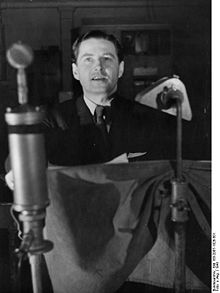- Die Deutsche Wochenschau
-
Die Deutsche Wochenschau (English: The German Weekly Newsreel) is a series of German newsreels from 1940 until the end of World War II.
After the invasion of Poland (September 1939, the outbreak of the Second World War), the Nazis consolidated four separate newsreel production efforts into one. These newsreels (Ufa-Tonwoche, Deulig-Tonwoche, Tobis-Woche, Fox-Tönende Wochenschau) were merged into a single wartime newsreel, but kept their respective opening titles until June 1940. After that, the merger was made public by use of a single new opening title: Die Deutsche Wochenschau.[1] This was the sole series of German newsreels until the end of World War II. It was a source of footage for late Nazi propaganda films such as Der Ewige Jude and Feldzug in Polen, as well as innumerable post-war documentaries. Despite Harry Giese's signature rat-a-tat narration that gives the proceedings a documentary-like tone, liberties were taken in retelling the facts in this Nazi propaganda tool.[2] Comedic public service announcements were delivered by the Tran and Helle duo.[3] Die Deutsche Wochenschau was also exported to occupied territories that had been annexed to the Reich, like Austria and the Grand Duchy of Luxemburg. For other occupied regions, or for neutral nations (like Sweden), another newsreel was made: Ufa's Auslandstonwoche or 'Foreign Weekly Newsreel'.[4]
Among the many notable scenes preserved by the newsreel are the Nazi point of view of the battle of Normandy, the footage of Hitler and Mussolini right after the July 20 plot, and the last footage of Hitler awarding Hitler Youth volunteers shortly before the Battle of Berlin. Its last documentary, Traitors before the People's Court, depicted the trial of the accused in the 20 July plot, and was never shown.[5]
Most Wochenschau films are still copyrighted; the rights are held by Transit Film GmbH in Germany. In the U.S. the copyright on these films from 1914 until the 1940s had expired due to non-compliance with U.S. formalities; the copyright was then restored in 1996 by the URAA on those published after 1922. The Transit Film company then even filed so-called "notices of intent to enforce" (NIEs) with the U.S. Copyright Office and can now even enforce its copyrights against parties who rightfully used their films before the URAA became effective. Nevertheless the URAA also prevents films previously under the administration of the "Enemy Property Custodian" from being renewed making it an uphill if not futile battle to enforce these copyrights in the U.S.
Contents
See also
- List of German films 1933–1945
- List of films in the public domain in the United States
- Wehrmachtbericht, another regular means of military propaganda from Nazi Germany
References
- ^ Bucher, Peter, "Goebbels und die Deutsche Wochenschau. Nationalsozialistische Filmpropaganda im Zweiten Weltkrieg 1939-1945", Militärgeschichtliche Mitteilungen, 15, 1986, 2, pp. 53-69.
- ^ Vande Winkel, Roel, "The Auxiliary Cruiser Thor's Death and Transfiguration: a case study in Nazi wartime newsreel propaganda", Historical Journal of Film, Radio and Television, 23, 2003, 3, pp. 211-229.
- ^ Singer, Hans-Jürgen, "Tran und Helle. Aspekte unterhaltender Aufklärung im Dritten Reich", Publizistik, 31, 1986, :3-4, pp. 347-356.
- ^ Vande Winkel, Roel, "Nazi newsreels in Europe, 1939-1945: the many faces of Ufa's foreign weekly newsreel (Auslandstonwoche) versus the German weekly newsreel (Deutsche Wochenschau)", Historical Journal of Film, Radio and Television, 24, 2004, 1, pp. 5-34
- ^ Robert Edwin Hertzstein, The War That Hitler Won p283 ISBN 399-11845-4
Further reading
- Bartels, Ulrike, Die Wochenschau im Dritten Reich: Entwicklung und Funktion eines Massenmediums unter besonderer Berücksichtigung völkisch-nationaler Inhalte, Frankfurt am Main - Berlin - Bern - Bruxelles - New York - Oxford - Wien, Peter Lang, 2004
- "Nazi newsreels in German-occupied Europe, 1939-1945". Special issue of the Historical Journal of Film, Radio and Television, 24, 2004, 1 (Table of contents)
- Zimmermann, Peter and Hoffmann, Kay (Editors), Geschichte des dokumentarischen Films in Deutschland. Band 3: Drittes Reich (1933–1945), Stuttgart, Philipp Reclam, 2005
External links
Categories:- 1940 establishments
- Nazi propaganda films
- Newsreels
Wikimedia Foundation. 2010.


